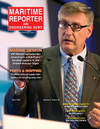
Page 25: of Maritime Reporter Magazine (September 2021)
The Marine Design Edition
Read this page in Pdf, Flash or Html5 edition of September 2021 Maritime Reporter Magazine
SHIP DESIGN MITIGATING RADIATED NOISE we expect underwater radiated noise
Lessons Learned targets to be included in a growing num-
In 2021 the ECHO Program contract- ed West Paci? c Marine to work with BC ber of new vessel builds. Understanding
Ferries to prepare a case study report to and managing the risk is necessary to encourage innovation.
capture the ? ndings and learnings sum- marized in this article. While the New
FIGURE 3: Propeller cavitation
Major Vessel Replacement Program pro- simulation modelling.
curement process has been delayed due to COVID-19 impacts, the case study report illustrated that the initial phases of work undertaken by BC Ferries have led to some key learnings for other vessel operators considering the implementa- tion of underwater radiated noise targets: • Obtain baseline measurements of your ? eet to determine where your start- ing point is before setting underwater noise reduction goals; • Make design decisions in consid- eration of the larger system. Underwa- ter radiated noise is a function of many complex interactions within a vessel, and as such, it is important to design the propeller and propulsion systems in concert with the hull design to ensure that functional requirements are ac- counted for; • Engage an underwater radiated noise expert to assess design impacts and conduct trade-off analysis. Ensure the expertise is available when work- ing closely with the selected shipyard throughout the detailed design and build process; • Anticipate con? icting requirements as a part of the design optimization pro- cess. For BC Ferries, for example, meet- ing underwater radiated noise reduction requirements while achieving improved energy ef? ciency is a balancing act that requires careful consideration.
Underwater radiated noise is still a nascent ? eld in the commercial shipping sector, but one that is gaining attention and focus. A collaborative work envi- ronment between the operator, owner, shipyard, naval architect and ship classi- ? cation society is vital. As we continue to improve our understanding of quiet vessel design’s possibilities and limits, www.marinelink.com 25
MR #9 (18-33).indd 25 9/7/2021 9:47:23 AM

 24
24

 26
26
